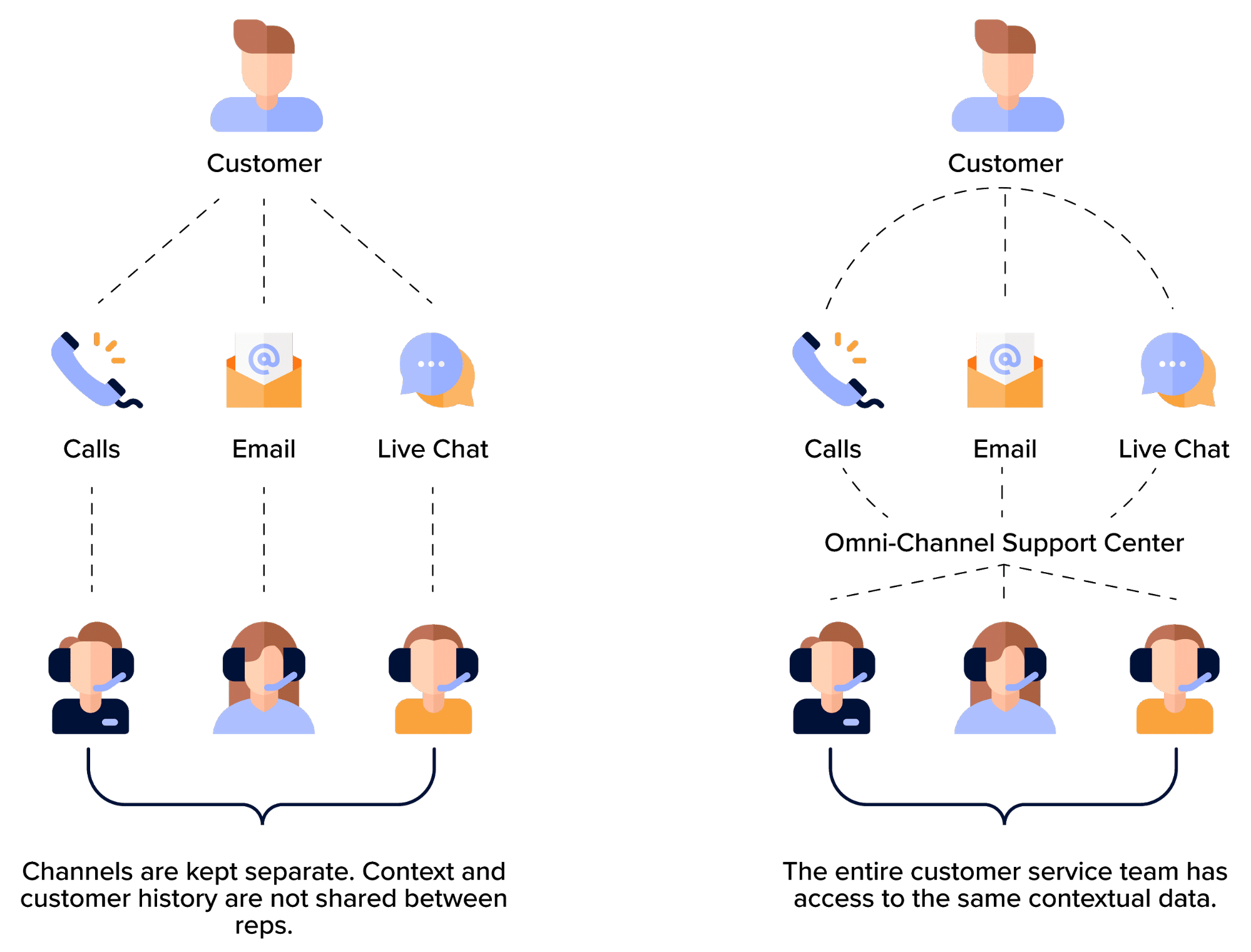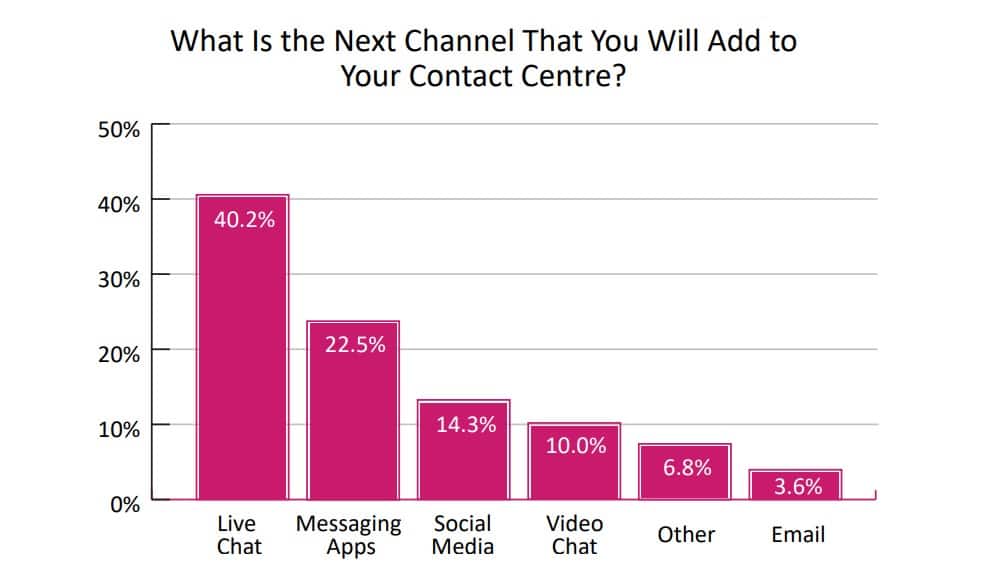As part of this series dedicated to call centres, we’re trying to drill down into the sector trends. We’ve already taken a look at broad tech developments and the shift to cloud-based contact systems. In our fifth post, we’re going to focus on the emergence and importance of omnichannel support.
The concept of omnichannel contact centres has become increasingly important in recent years. It’s something that businesses are heavily investing in. It’s also something that consumers demand.
In this post, we’re going to discuss the trend toward omnichannel. We’ll consider the channels that most contact centres now cater to. Finally, we’ll discuss why omnichannel centres are still developing, and what more changes may be afoot.
Multichannel Vs. Omnichannel – A Primer
The very first call centres were worthy of that name. They were locations staffed by agents who were there to speak to customers over the phone. Making a phone call was a consumer’s only option when they needed to contact customer service.
As technology developed, things changed. Over the decades, businesses introduced more options for customers to reach out. Email support followed traditional telephony. Those channels were then supplemented by live chat, social media, and more.
A firm that lets people seek help via many channels offers a multichannel solution. By extension, that’s also how to describe a contact centre that facilitates the firm’s customer service. Providing omnichannel support means taking things a step further.

The central premise of omnichannel support is that the customer service someone gets is seamless. It shouldn’t matter by which channel they reach out to a firm; support should always be consistent. In theory, all avenues of support get fully and efficiently integrated.
An omnichannel contact centre is one that customers can reach in a variety of ways. More than that, it’s one where all channels get incorporated into a unified system. That lets agents jump between channels with ease. They can retrieve historical conversations from any channel as they do so. Customers don’t need to restate support requests each time they change channels.
That customers want to use different channels for support is evident. There’s also a significant demand for omnichannel support from consumers. Salesforce research found that 70% of customers see connected processes is vital to winning their custom.
It’s for this reason that contact centres are so keen on the idea of broadening the range of channels they use. Only 19% of call centre advisors support a single channel, according to UKCCF research.
Which Channels Comprise Omnichannel Support Systems?
There is a plethora of choice when it comes to the channels that firms and contact centres can offer to consumers. Telephony is still the predominant channel industry-wide. Annual Call Centre Helper surveys always rate calls as the most popular channel. The experts we spoke to at Cymphony and FM Outsource agreed.
At Cymphony, 92% of revenue gets accounted for by voice calls. The representatives from FM Outsource additionally rated calling as the top channel. That was both in terms of volume and the importance placed upon the channel by the company’s clients.
Our industry insiders also agreed on the most valuable channels. They all flagged up the popularity of webchat and social media. For the latter, especially instant and private messaging via social networks. In fact, Jack Barmby, founder of FM Outsource, shared some fascinating insights about messaging channels.
Social Media: The New Player in Town
At FM Outsource, social media – and particularly Facebook Messenger – is on the rise as a support channel. For the fast fashion niche, private messaging via Facebook Messenger is one of the highest volume channels. Such IM features of social networks are also becoming more popular across the board.
Interestingly, neither Cymphony nor FM Outsource mentioned email as a vital channel. Email support is still provided for by many contact centres. A State of Customer Experience Study found that almost half of centres do cater to the channel.
Call Centre Helper’s research, though, does suggest that live chat channels are taking traffic from email. The reason is likely because those channels offer more immediate resolution than email. It’s also more convenient than a phone call. This final point is vital to the millennial generation, especially. That sector of society strongly prefers online to offline communication.
What does all this information reveal? It tells us that contact centres are alive to the demand for multiple support channels. It’s also clear that industry pros see web chat or IM channels as the most useful of the newer options around. As we mentioned earlier, though, adding new channels isn’t all there is to omnichannel support.
What Are the Principal Hurdles to Omnichannel Support?
A genuine omnichannel contact centre is one that provides seamless support. Customers can reach agents via many different channels. Those channels each offer the same level of service. Beyond that, advisors can also view data from any channel when they converse with a customer.
For seamless customer experience, a contact centre must integrate its channels. All means of communicating with agents need to exist on a unified platform. Surprisingly, that’s not the case with the vast majority of contact centres as they’re currently constructed.

Source: Call Centre Helper
As the above graphic from Call Centre Helper shows, very few centres achieve full integration. What’s far more common is a muddled situation where some channels are unified, and others aren’t. This difficulty in integration is often cited as the principal hurdle to omnichannel.
David Rolfe, at Cymphony, agreed. He revealed that the firm plans to adopt a unified communications platform. And the primary reason is to provide an environment for omnichannel. He described the current situation as disjointed: “People come in very different channels. At the moment, we’ve got no way of connecting the dots.” A UC platform would give them that means. The very premise of such solutions is to integrate communication channels and accounts in one interface.
At FM Outsource, the situation’s a little different, all their channels are fully integrated. They see the integration of first and third-party systems as the most significant hurdle to omnichannel and believe that it’s challenging to find a “coherent pathway for data” through those systems.
Without such a pathway, utilisation of the data isn’t as efficient as it might be. For instance, a coherent avenue for data can make post-call processing much more straightforward. An agent would be able to update an address or other details in the contact system. The changes would then get automatically replicated elsewhere. That would include CRM, delivery tracking, and other related platforms.
The key to omnichannel support is to have a unified, joined-up system. That means the proper integration of channels and other software, platforms, and solutions. Contact centres are sure to strive towards that kind of unification in the coming years. What other changes and trends, though, might be on the horizon?
Looking Ahead – New Channels & Trends
Contact centres are always adding new channels for customer support. Doing so is necessary to keep up with consumer demands and preferences. We asked both Cymphony and FM Outsource which new channels they were going to introduce next. Once again, our pros agreed.
WhatsApp for Business, Apple Business Chat, and IM channels, in general, are the paths that both firms plan to explore. That chimes with Call Centre Helper’s industry research. Their recent survey showed live chat and messaging apps as the most popular new channels:

Source: Call Centre Helper
Jack from FM Outsource made an important distinction between those two options. They feel that messaging apps and IM channels linked to social networks may be the better option. There were two main reasons they gave as to why those channels may gain more popularity than webchat:
- They’re less of a live environment
- They’re more familiar as modes of communication
A web chat function offered by a company has a certain immediacy. It’s a channel specifically designed for customer support. A consumer who uses it has decided to concentrate on solving whatever problem they have. Messaging apps are a bit different.
Customers tend to treat those apps more like email when it comes to seeking support. They expect brands to respond as swiftly as possible. They aren’t, though, keyed into solving their issue straight away. They may read a response or reply to it at a later time or date at their convenience.
Using messaging apps in that way is more in line with how people converse in their day-to-day lives. It’s how they use IM to communicate with friends and loved ones. That familiarity is a further reason why IM channels may get more popular as a customer support channel. As is the fact that the apps often offer a smoother experience on mobile than dedicated webchat functions.
Omnichannel has Arrived but it’s Still Developing
The days of single-channel contact centres are long gone. Consumers demand to be able to reach out to brands whenever and however suits them best. It’s why you’ll struggle to find a thriving contact centre that doesn’t handle at least a few separate channels. In many cases, though, it is still the case that those channels are separate.
There’s consensus across the contact centre niche that omnichannel support is something for which to aim. The benefits of fully unified and integrated systems are too vast to get ignored. A centre that achieves a path for data through all channels and systems is more likely to succeed.
At present, though, the theory of omnichannel support hasn’t yet been broadly made reality. Difficulties integrating diverse platforms and encouraging data sharing between them remain. Those hurdles must be overcome for omnichannel to become the norm. With the industry trending toward such systems, though, it may merely be a matter of time.
Originally published Jun 14, 2020, updated Jan 17, 2023
